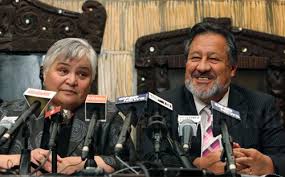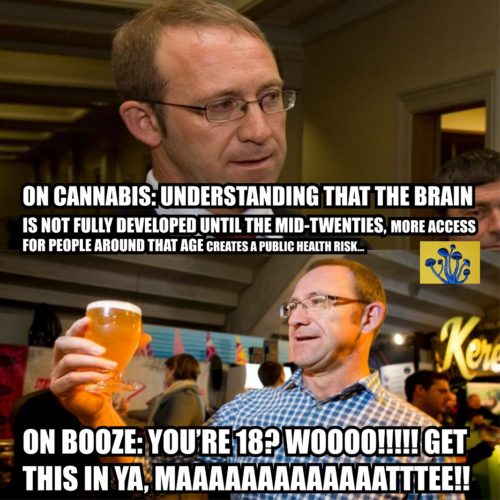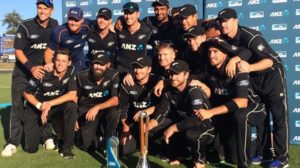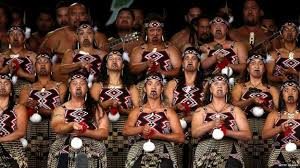
The Maori Party is a bit of a misnomer. Sure, they represent Maori, but not all Maori – only some. Let’s get the obvious one out of the way: the correlation between voting Maori Party in 2014 and being of Maori descent is an extremely strong 0.91. The correlation between voting Maori Party in 2014 and being a Pacific Islander was a not significant 0.01, and the other two correlations, with being European and being Asian, were both significantly negative at -0.35 and -0.30 respectively.
What may seem incredible if you look at Parliament, but not surprising if you knew about Kiwis, is the size of the negative correlation between voting National in 2014 and voting Maori Party in 2014: this is -0.75. That is enough to suggest that the average Maori Party voter has very, very little in common with the average National voter, even though the Maori Party supports National in Parliament.
With no other party was there as large a negative correlation with voting Maori Party in 2014. Voting Maori Party had a correlation of -0.64 with voting Conservative, and -0.29 with voting ACT. Imagining some kind of blend of National, Conservative and ACT voters can give us an idea of what an anti-Maori would be like if one existed.
Maori Party voters were indifferent to the Greens. Voting Maori Party in 2014 had a correlation of 0.02 with voting Green in 2014. They do, however, seem to like the other strongly pro-Maori parties. Voting Maori Party in 2014 had a correlation of 0.41 with voting Labour and a correlation of 0.46 with voting New Zealand First.
The strongest correlations with voting for the Maori Party were with Internet MANA (0.84) and the Aotearoa Legalise Cannabis Party (0.85). Those two correlations may give a clue as to the sense of betrayal that many hard done by Maori will be feeling at the actions of the Maori Party MPs elected to Parliament, who raised tobacco taxes and did nothing about cannabis prohibition.
There is a fairly big difference between some correlations that the reader may have expected to be close to equal. One set of them relates to the strength of the correlation between being educated and being Maori and between being educated and voting Maori Party.
The correlation between being Maori and having a Bachelor’s degree is -0.45, but the correlation between voting Maori Party in 2014 and having a Bachelor’s degree is only -0.28. There was a similar pattern for all of the postgraduate degrees.
For being Maori and having an Honour’s degree the correlation was -0.46, but for voting Maori Party in 2014 and having an Honour’s degree it was only -0.29. For being Maori and having a Master’s degree the correlation was -0.45, but for voting Maori Party in 2014 and having a Master’s degree it was -0.28. And for being Maori and having a doctorate was -0.41, but for voting Maori Party in 2014 and having a doctorate it was 0.27.
A similar pattern repeats itself if we look at correlations with income bands. The $60-70K income band is perfectly even, in that the correlations between being in this band and being either Maori or voting Maori Party are both exactly 0.00.
For all of the income bands below this, the correlation with being Maori was more strongly positive than it was for voting Maori Party in 2014, but the opposite was true of the three income bands above this one.
A similar pattern repeats if one examines the difference when it comes to claiming benefits. The correlation between being on the unemployment benefit and voting Maori Party in 2014 is 0.79, but the correlation between being on the unemployment benefit and being Maori is 0.91. Similarly, the correlation between being on the invalid’s benefit and voting Maori Party in 2014 is 0.59, but the correlation between being on the invalid’s benefit and being Maori is 0.77.
One difference, and one major clue as to how Maori Party voters differ from general Maori, is that the correlation between being on a student allowance and voting Maori Party in 2014 (0.26) is stronger than the correlation between being on a student allowance and being Maori (0.20). This tells us that the average Maori Party voter is generally more driven and aspirational than the average Maori.
A general picture emerges of Maori Party voters being significantly better off than the average Maori person. This cannot be explained by turnout alone. The correlation between turnout rate in 2014 and being Maori is -0.75, and with between turnout rate in 2014 and voting Maori Party in 2014 it is -0.74. So there is no significant difference there.
This is supported by general measures of health and well-being. The correlation between having never smoked tobacco and voting Maori Party in 2014 (-0.55) is weaker than the correlation between having never smoked tobacco and being Maori (-0.73). In a similar vein, the correlation between being a solo parent and voting Maori Party in 2014 (0.66) was not as strong as the correlation between being a solo parent and being Maori (0.79).
There are several potential implications of this. One of the most notable is that, if Maori Party voters are actually significantly wealthier than the average Maori, a partnership with National as not as odd as it might otherwise appear.
*
This article is an excerpt from Understanding New Zealand, by Dan McGlashan, published by VJM Publishing in the winter of 2017.



